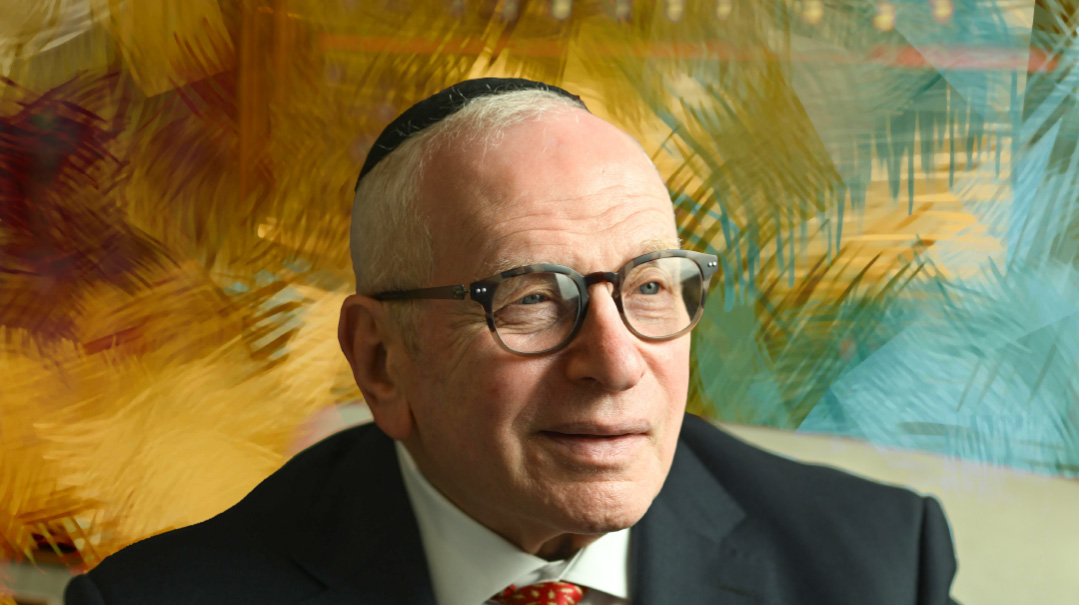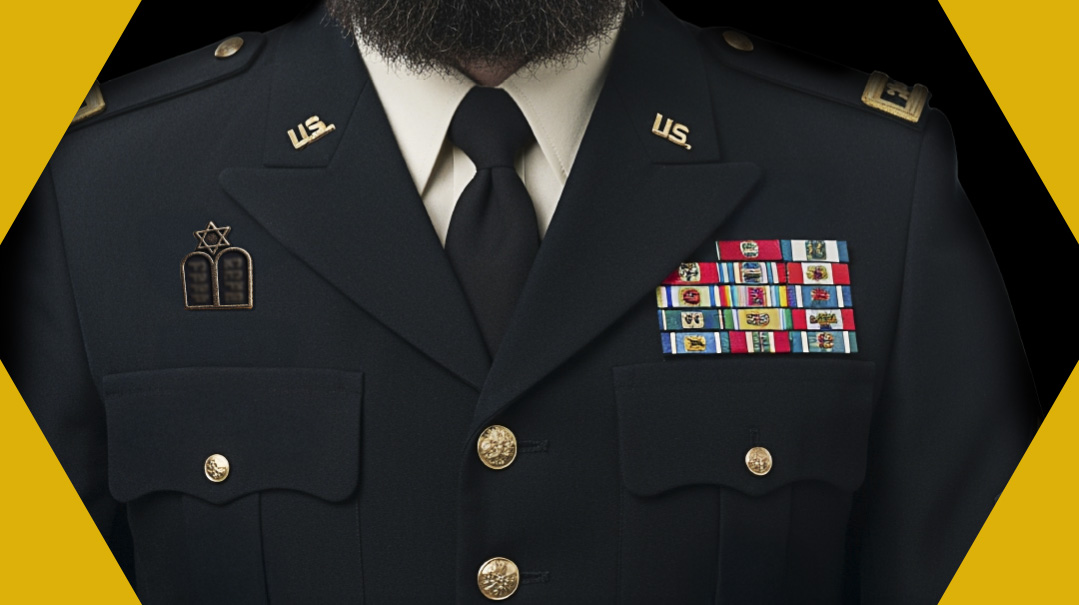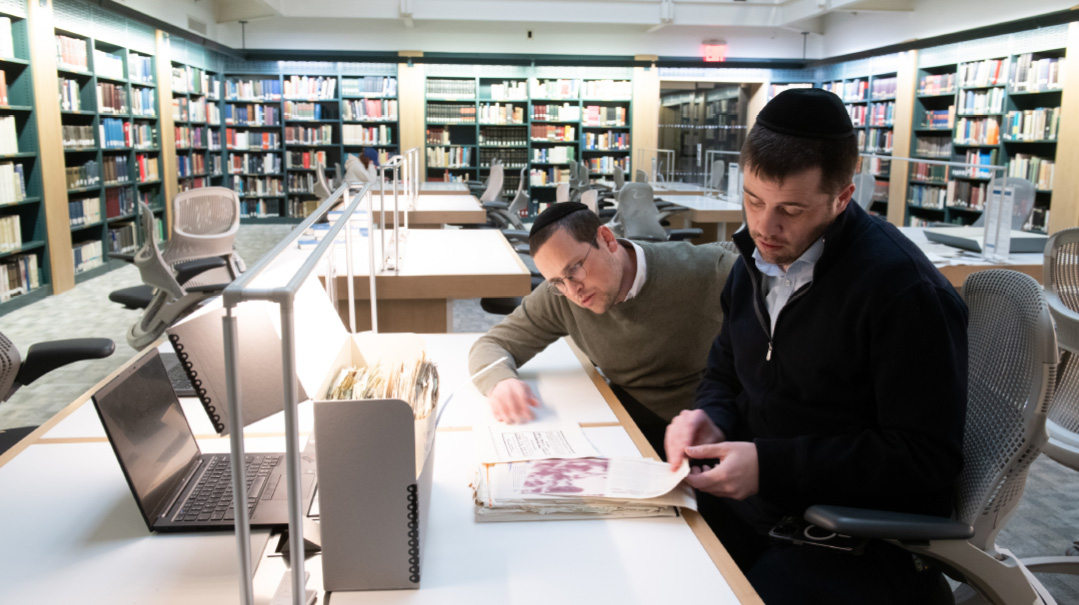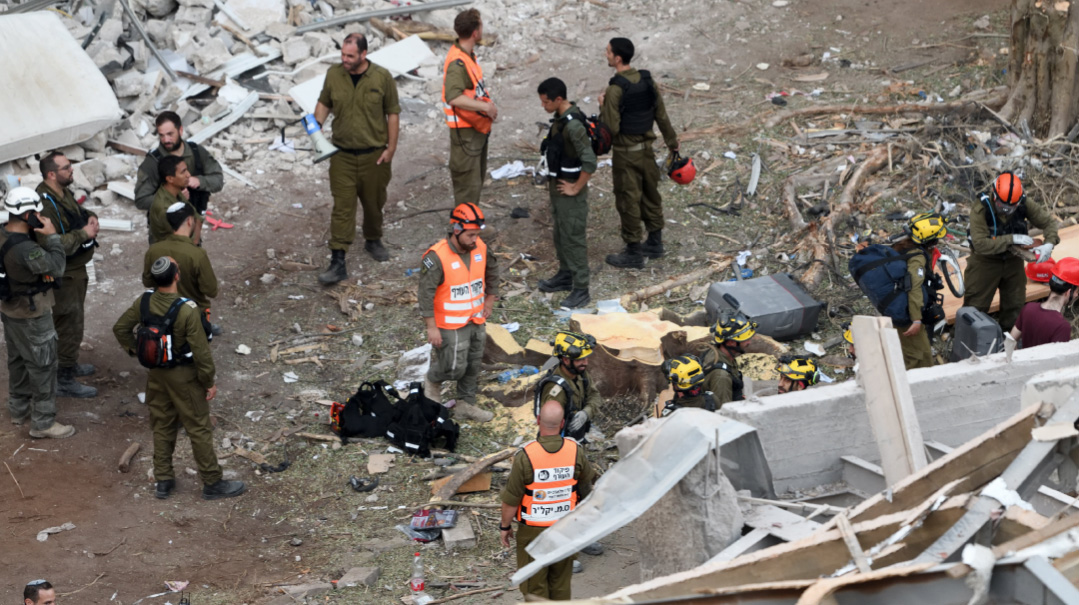Keep Climbing
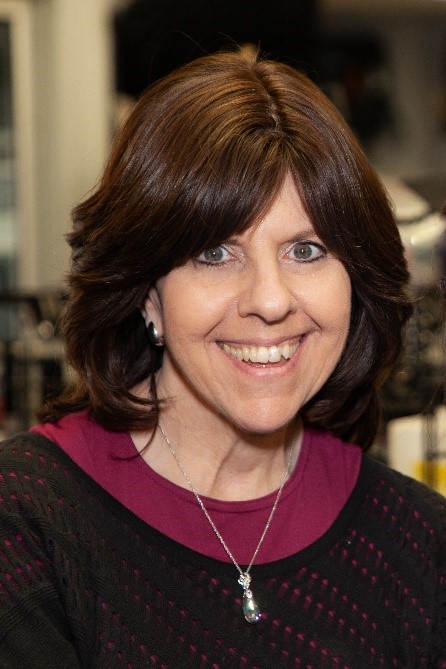
As he spent most of his childhood years in and out of hospitals, Johns Hopkins’ Children’s Center holds a special place for Rabbi Rabinowitz, who
was once a patient there himself. “I knew I could help younger patients with their struggles”
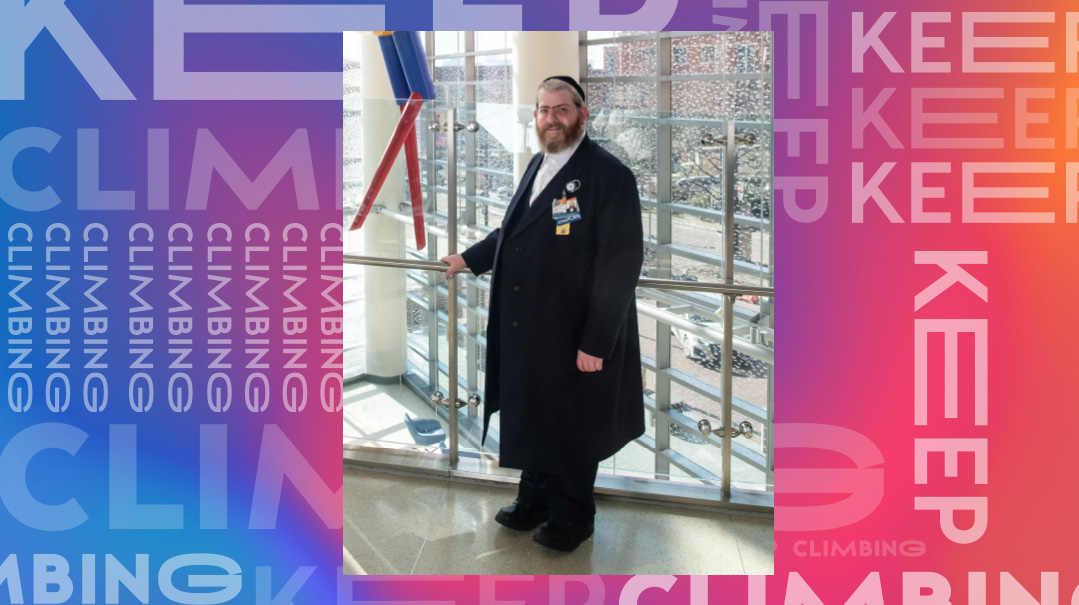
When Rabbi Naftali Rabinowitz became the Jewish chaplain at Johns Hopkins Hospital in Baltimore, it was both the closing of a circle and the opening of new doors. Born with spina bifida, as a child he traveled from Eretz Yisrael with his parents to receive life-altering treatment at the very medical center where he’s now employed. And it’s also a testament to the possibilities open to those who thought life basically ended with this particular birth defect
By Margie Pensak
Photos Eli Greengart
Rabbi Naftali Rabinowitz is an anomaly in the halls of Johns Hopkins medical center. Dressed in his black rekel, peyos neatly curled behind his ears, the Skolya chassid stands out in stark contrast to the tens of thousands of people who frequent the world-class hospital daily. Yet this board-certified Jewish chaplain services patients of every denomination in the very hospital in which he was treated as a child over 24 years ago.
Eight-year-old Naftali, who was born with spina bifida, traveled with his family from Jerusalem to Baltimore for a surgical procedure with Johns Hopkins’ pediatric urologist Dr. John Gearhart. Although the original plan was to stay for only six weeks, the Rabinowitz family ended up moving to the warm, welcoming Baltimore community who had embraced them as they navigated their complex medical journey on foreign soil.
How fitting that I caught up with Rabbi Rabinowitz at the entrance to the Johns Hopkins Children Center, where he began his Johns Hopkins experience, so different from where he is now.
As the medical center’s Jewish chaplain, Rabbi Rabinowitz is on call 24/7 for the hospital’s Jewish population, in addition to his regular Monday-Thursday in-house hours. The hospital has chaplaincy coverage around the clock, divided between each of the denominational chaplains, and he has one of those shifts as well. He’s often the liaison between staff, families, and rabbanim — both local and international — and has the private cell phone numbers and the Minchah/Maariv schedule of the city’s rabbanim, whom he might need to catch in shul when their phones are off. He also facilitates lines of communication between the doctors and rabbanim, who often only hear the family’s perspective without balanced medical information.
And mostly, because he spent his own younger years in and out of hospitals while his American-born father and Israeli mother were trying to navigate a new world of medical breakthroughs and promise, he wants to make sure every Jewish patient has an address for both the complex questions and dilemmas, as well as the easier, more technical issues that arise in every hospital setting.
Rabbi pinchos rabinowitz, Naftali’s father, was born and grew up in Brooklyn, where he learned in the Bobover yeshivah and then in Eretz Yisrael, after his parents made aliyah in the 1980s. While in Eretz Yisrael, Reb Pinchos and his father, a distant cousin of the Skolya Rebbe in Boro Park, remained close to Skolya and to the rebbes of Bobov. In 1992, Reb Pinchos married Faigy Schwartz (a sister of the famed Belzer badchan Yonoson Schwartz) in Jerusalem, and the following year, Naftali was born. The Belzer Rebbe and Rebbetzin, who took care of Faigy Schwartz and her siblings after Faigy’s mother died at the young age of 31, were very involved in Naftali’s health, arranging for the best doctors and treatment protocols, and were always there for emotional support.
Naftali’s early years were quite challenging, for both his parents and himself. As a baby with spina bifida — an incomplete closing of the spine and the membranes around the spinal cord during early dvelopment in the womb, causing nerve damage from below the gap — he had multiple surgeries to stabilize his condition. As a two-month-old, Naftali went daily to Alyn Hospital in Jerusalem for PT, OT, hydrotherapy, and more, eventually reaching most of his “normal” milestones.
As Naftali grew, many other things children his age took for granted were a challenge, and some accommodations were required when he started school. But Naftali was a smart, cute preschooler, and his parents fought for him to attend a regular school, standing up to the many obstacles and red tape that were put in their way.
When Naftali was five, his parents took him to the US to look into some of the new treatments and procedures available to help ease daily life for children with spina bifida. They met with specialists in both New York and Baltimore, but it was determined that he was still too young for many of the treatments. They went back home, but returned with Naftali when he was eight. At the time, the specific procedure Naftali needed was new, and although one or two doctors in Israel were familiar with it, they advised that since Naftali was a US citizen and able to get insurance, it should be done in Baltimore, where the procedure was developed and implemented with the most success.
When the Rabinowitzes arrived in the US for the scheduled surgery, they discovered that their insurance had a last-minute complication, and surgery was pushed off for a few months. At that point the Reb Pinchos and his wife looked into other medical solutions for spina bifida-related issues, and found that the US had much more to offer. And so with the brachos of the Belzer, Bobover, and Skolya Rebbes, they decided to stay in Baltimore to further Naftali’s progress.
Once they settled in Baltimore, Naftali needed a school, and Talmudical Academy of Baltimore seemed like the best fit. TA was very accommodating in all his needs, from his second-grade rebbi Rabbi Boruch Brull through the hanhalah. He remained there through 12th grade, where he graduated from the high school with honors.
After high school, he joined a yeshivah in Lakewood and then returned to Baltimore to learn in Ner Yisroel. And throughout his educational journey, Naftali always had a close-knit group of friends who rallied around him for his every need. They carried him up the steps in his wheelchair after surgeries, and made sure to schedule activities that Naftali could join. When he was out of school for still another surgery, they would make sure to visit each day to keep him in the loop. When another kid would bully him, his friends made sure to stick up for him.
In 2019, he was introduced to Simi Klein, whose parents, Heshy and Nechama Klein, also started off in Jerusalem and returned to the US to seek better medical care after Simi was born with spina bifida. The Rabinowitzes and Kleins actually knew each other from get-togethers of frum families going through the same challenge, and the shidduch was made by a cousin, together with the mother of another child with spina bifida in the group.
Rabbi Pinchos Rabinowitz, meanwhile, had become Bikur Cholim of Baltimore’s Director of Clinical Services. The position evolved for him when, after settling in Baltimore, he got a job at the local seforim store and became a volunteer for Bikur Cholim of Baltimore. With his chassidish background, fluency in Hebrew and Yiddish, medical experience and natural compassion, he found himself called upon whenever a translation was needed or if there was some kind of culture gap that had to be smoothed over. When Bikur Cholim decided to hire someone for the senior clinical services position, many rabbanim and askanim in town requested he apply.
And his son wasn’t far behind.
“Growing up with spina bifida and being in and out of the hospital so often, I saw the importance of having someone visit and to be able to talk to. I also realized that I could help younger patients with their struggles,” Rabbi Naftali Rabinowitz tells Mishpacha. “At one point, I debated going into chaplaincy or social work, which overlap a little. I knew Rabbi Tsvi Schur, the longtime hospital and hospice chaplain who’d been at Johns Hopkins for thirteen years, and asked him if I could shadow him. He was the one who convinced me to take the CPE (Clinical Pastoral Education) courses for a post-master’s degree. I have a master’s in Torah Law from Ner Yisroel, which is the equivalent in a master’s in Divinity. But to become a chaplain, you also need four units of clinical pastoral education, which can take up to two years. He encouraged me to sign up for the units and a residency at Johns Hopkins.”
Rabbi Rabinowitz says that although spina bifida doesn’t impact his job, it does impact his everyday life.
“It’s a spinal cord defect that affects the entire system from the point where the lesion is and below that,” he explains. “Most people with spina bifida have issues with walking, for example. People with my level of spina bifida generally aren’t able to walk. When I was born, the doctor said I would never walk. But my parents, undeterred, got brachos from the Belzer Rebbe and the previous Bobover Rebbe, Rebbe Shloime ztz”l. I started walking when I was two and a half with a walker. I got a lot of physical therapy, for many years almost daily. When my mother brought me — walking — into the nonreligious doctor’s office, he looked up and said, ‘What can I say? You people have a G-d.’ ”
Naftali slightly lifts up one of the cuffs on his pants to reveal his brace. I had no clue.
He explains, “I wear braces on my legs that go up until my knees, but when I first started walking, I wore braces that went up to my waist.”
In 2022, Naftali and Simi founded “Keep Climbing,” an organization that gives support services to assist Jewish families as they navigate the various stages and challenges of spina bifida, from diagnosis through adulthood.
Prior to Keep Climbing, families had to do their own research regarding physicians and organizations.
“Some of these families can feel very lost and some doctors, even today, will give over a very bleak prognois for spina bifida. According to US statistics, only 40 percent of spina bifida fetuses even make it out of the womb. So just helping the family understand that it isn’t a death sentence and that there is light at the end of the tunnel is vital.” Furthermore, the organization makes available the central database of doctors that people have used, and their experiences with them.
But, he notes, spina bifida is called the “snowflake disease,” because just as every snowflake is unique, so, too, is every spina bifida case.
“I have a very close friend who was born in the same hospital as I was — we’re a week apart,” Rabbi Rabinowitz relates. “We met during therapy in Eretz Yisrael. Technically, he has a better diagnosis than me — the lower it is in the spine, the better the outcome. But I walk and he doesn’t. He’s had one surgery, and I’ve had more than 30.”
Rabbi Rabinowitz explains that most people with spina bifida have urological issues — and that’s why he and his parents came to Hopkins and Dr. Gearhart so many years ago. Today, Dr. Gearhart is on the board of the organization.
“Our organization is currently helping over 150 families as they go through the various stages of spina bifida. We’re in touch with new doctors, who refer new cases to us, and to date we sponsor seven monthly support groups. This past winter, we made a shabbaton in a hotel in Stamford, Connecticut. Participants came from as far away as Israel and Mexico. They want to see those of us who are success stories, who lead normal lives — those of us who never gave up and kept going.”
In addition to interfacing with Jewish patients in his role as chaplain, for Rabbi Rabinowitz, it’s also about working with the nurses and other staff members to understand the cultural differences and nuances relating to this subpopulation.
“I actually wrote a pamphlet about dealing with Orthodox Jewish hospital patients, from not shaking hands to keeping in mind the basic dos and don’ts in end-of-life situations,” he says. “It emphasizes reaching out to the on-call chaplain as soon as you know the patient is heading toward end-of-life, so that chaplain will reach out to me.”
Rabbi Rabinowitz is always on call during Shabbos and Yom Tov, carrying his pager on those days. He tells about a case in which the mother of a young patient, a seven-year-old child, was visiting with her young son, together with her newborn baby, was told as Shabbos approached that she’d have to leave. She could not stay overnight with her baby in the hospital.
“When things escalated,” Rabbi Rabinowitz remembers, “the on-call chaplain reached out to me. I was spending Shabbos with my in-laws when I got the call. My first thought was that this is a visitor restriction situation, not a pikuach nefesh one. But knowing the mother and the hospital culture, and after speaking it over with a rav, I realized that the mother could not fathom leaving her child — the patient — alone at the hospital. It was winter, and she would be sitting outdoors the entire night in the cold, with her infant. That, already, is pikuach nefesh. And so I called back to see if we could work something out, and we did.”
Johns Hopkins has 55 in-patient nursing units, 1,149 beds, approximately 10,000 annual admissions, and 12,000 staff members on its East Baltimore campus alone. There are 16 chaplains, primarily from a variety of Christian denominations, and Rabbi Rabinowitz is the sole Jewish chaplain who, at any one time, services an average of 30-50 Jewish patients, a dozen of whom are typically frum.
“I see patients from all walks of life,” he says. “They run the gamut from those who say their dad is Jewish to patients who live in Meah Shearim and Bnei Brak. My job is to see anyone who considers themself Jewish. I need to be with the patients wherever they are in this medical journey. If they’re not ready to accept the diagnosis, my job is not to say, ‘This is what you need to do,’ or get them to accept it. It’s really to just be there for them and hopefully help them process some of it. We’re here for emotional and spiritual support, not to change or to preach.”
His typical day at the hospital begins around 9:30 a.m., but he’s on-call 24/ 7, so no day in his six years here has ever really been the same.
“I can get called early in the morning and late at night — especially if there’s been a turn for the worse or an end-of-life situation,” he says. “Every morning when I arrive, I see what’s going on around the hospital, searching the charts for Jewish patients. Since the ER can be a bit chaotic, those who come by ambulance may have their religion listed as “other,” “unknown,” or “none.” Sometimes I have to hear from community members, Bikur Cholim of Baltimore, Jewish Caring Network’s Tikva House, or Chai Lifeline, that a Jewish patient has been admitted. I see who is new to the hospital, who was recently transferred to the ICU or hopefully, downgraded. I keep track of what’s going on in the hospital and also pop into the Bikur Cholim room, which is right across from my office, to make sure it’s well-stocked. The Bikur Cholim room is an oasis for Torah-observant employees, patients, and visitors. It offers a variety of foods, seforim, and Shabbos amenities.”
“Baruch Hashem, the hospital is very respectful of religion,” he continues. “They really do try to accommodate as much as they can. There are so many incidents that show how the place goes above and beyond to accommodate those in our community.”
Several years ago, a very prominent Rebbe was a patient at the hospital — he ultimately ended up passing away while here. But while he was here, the hospital worked very hard to accommodate the family and their needs. While the Rebbe was in the ICU and people heard he wasn’t going to make it, hundreds of his chassidim came down to the hospital.
“Now, ICU rooms only allow two people at a time to visit,” notes Reb Naftali. “So my father and I sat down with the administrating team and explained the significance and the need of the Rebbe’s chassidim to be with him. They ended up allowing up to the ‘fire maximum’ limit in the room — about fifty people. They locked the whole unit down. Even my badge, which works everywhere in the hospital, was not working there. I had to show my badge through the window to be allowed in. They monitored the ins and outs of the chassidim: When ten left, ten more were allowed in. During the last forty-eight hours of the Rebbe’s life, there were probably a few hundred people going in and out.”
The Rebbe’s family had reached out to Rabbi Rabinowitz regarding using the staircase rather than the Shabbos elevator. They asked if the hospital could shut off the sensors in the stairwells (although the light is always on, it gets brighter when it senses people).
“My father sent an email to the hospital to see if there was any way it could shut down these sensors,” recalls Rabbi Rabinowitz. “He got back a message saying, ‘We just want to let you know that while the family is in the hospital, all the sensors from the floor he is on, all the way to the ground, have been turned off.’ My father went to check what they did. There was no button to turn them all off, which means that someone had to physically go up on a ladder and cover each sensor with tape.
“The hospital is very, very accommodating, and they will reach out to me in anticipation of a halachically complicated end-of-life situation so that the family can follow halachah, speak to their rav, and make a plan. One of the head doctors in the pediatric ICU even mentioned to me, ‘This is the first time in my career that I need to talk things over with a rabbi.’ ”
Even during Covid and the accompanying restrictions, which landed at the beginning of Rabbi Rabinowitz’s tenure, the hospital was as accommodating as possible.
“The first Rosh Hashanah of Covid,” he relates, “we had a frum patient who was in the ICU, who told the unit staff before Rosh Hashanah that she felt devastated that she wouldn’t be able to hear the shofar that year. The unit staff reached out to us to see what could be done to accommodate her. We were able to organize a volunteer to stand outside of the hospital, right next to the door, and the unit staff wheeled her down with her hospital bed and IV poles to this entrance so that the volunteer could blow the shofar for her.”
Sometimes it’s not about helping out an individual or family, but rather helping the staff understand the needs of the patients.
“There are certain fertility procedures that require halachic supervision, to make sure that the biological material is being watched the entire time,” Rabbi Rabinowitz relates. “There is a certain rav who specializes in these things, who sits in the lab during the procedure and makes sure that everything is being dealt with the right way. The nurse reached out to me prior to the procedure and said, ‘I never heard of such a thing. We have a rabbi who wants to be in on the surgery. Is this something that you have ever heard of?’ I had to explain what that means and how that works, reassuring them that this is not just some community rabbi who wants to observe a surgery. There is a real religious need here, and this is a rabbi who knows what sterile means and knows how to be in a surgical suite. They ended up allowing it because of that discussion.”
One person who is particularly grateful about the full-time presence of Rabbi Rabinowitz is Chaplain Matt Norvell, a Baptist-trained reverend who is the clinical manager of Johns Hopkins’ Department of Spiritual Care and Chaplaincy.
“Before Rabbi Rabinowitz took on the full-time position, I sometimes wound up being the frontline explainer of things like, ‘Don’t worry that the kitchen put a carton of milk on the double-wrapped meat tray, as long as it is not touching the meat,’” he jokes, “To be honest, most people don’t take that explanation from me as well as they would take it from Rabbi Naftali, even though I’m a pretty nice guy. (Before Reb Naftali came on board, Rabbi Tsvi Schur was always available, but he was only physically on the hospital campus twice a week.)
“I interface with all the patients,” he continues, “but the Jewish patients need someone like Rabbi Naftali to have a real relationship with them. Sometimes he knows before they even get to the hospital, knowing that they’re coming, knowing where they’re from, knowing who they’re connected to in the community. The rest of us just don’t have that sort of insider community knowledge, and it makes such a difference to be able to provide the right care to the patients so they can get what they need while they’re here and be taken care of as a whole unit.”
Just so there will be no confusion or misunderstandings, Rabbi Rabinowitz sends an email to everyone within the chaplaincy department ahead of an upcoming Yom Tov to explain the main points of the holiday. Prior to Rosh Hashanah, for example, he will explain shofar blowing and inform the staff that there will be volunteers coming to blow shofar during the holiday. (Since the hospital is miles from Northwest Baltimore’s frum communities, the volunteers stay with Rabbi Levi Druk at Chabad of Downtown and walk about two miles round trip.)
“About a year ago, we had a patient who came to the emergency room on a Wednesday and was admitted,” Rabbi Rabinowitz relates. “His bar mitzvah was planned for that Shabbos and out-of-town relatives would soon be arriving. I spoke to the staff to see if there was any way we could allow him to go home for Shabbos, whether with a nurse or paramedic. Unfortunately, they were not able to discharge him. So we celebrated the actual bar mitzvah day with him, complete with music, in the Bikur Cholim Room. His rebbeim and friends came. For Shabbos, we were in touch with Jewish Caring Network’s Tikva House, Bikur Cholim, and Chai Lifeline to make sure we could accommodate the family coming in. We spoke to security to make sure they would let in the family and those on their guestlist. We were able to have a minyan in the hospital with a sefer Torah. They made a whole Shabbos bar mitzvah here, with all the frills!”
Reverand Norvell recalls the event. “Being a patient in the hospital is terrible, even for relatively benign things,” he says. “You’re not in your home, you’re away from your family, away from your community. To have people come in who represent who you are, who are familiar with you, that’s such a comforting thing.”
Not only could Rabbi Rabinowitz relate to this young man on a religious level, he could empathize with him as a former young patient of Bloomberg 10 South, one of the units in the Children’s Center. (There are nurses on that floor who still recognize their former patient, despite his beard.)
“I personally feel the pain of young kids,” Rabbi Rabinowitz says, “but I need an extra dose of siyata d’Shmaya when dealing with complex family dynamics in a medically and halachically complicated case.”
For such cases, he needs to understand both the medical and halachic implications so he can identify sh’eilos and encourage the patient and family to ask them to their own rav.
“I once had a patient who came in as a DNR (Do Not Resuscitate) and DNI (Do Not Intubate), and the family told me they don’t need a rav because their children were rabbanim. Based on the man’s chart, I wasn’t so comfortable with that decision, and so after explaining the importance of having a rav who understands all the medical ramifications and is looking at the situation objectively, they reached out to a particular rav, who told them to make the patient Full Code (receive all possible life-saving measures in the event of a cardiac or respiratory arrest). This change in DNR/DNI code allowed the staff to do things that they were not previously permitted to do. The patient was discharged a few weeks later, went home, and is still alive today.”
“Before I walk into a room, ” he continues, " I say a tefillah that Hashem should put the right words into my mouth.”
(Originally featured in Mishpacha, Issue 1060)
Oops! We could not locate your form.

